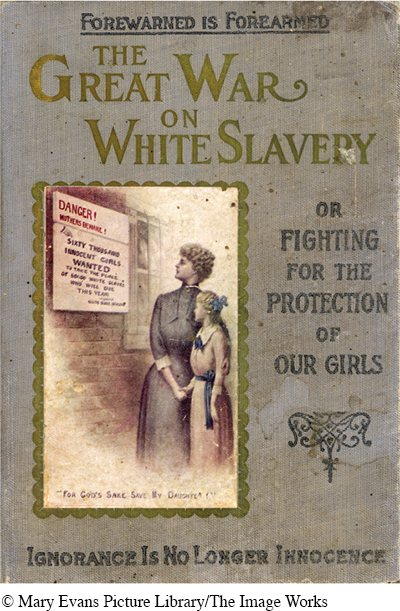Prostitution, Narcotics, and Juvenile Delinquency
Alarmed by the increased number of brothels and “streetwalkers” that accompanied the growth of cities, progressives sought to eliminate prostitution. Some framed the issue in terms of public health, linking prostitution to the spread of sexually transmitted diseases. Others presented it as an effort to protect female virtue. Such reformers were generally interested only in white women, who, unlike African American and Asian women in similar circumstances, were considered sexual innocents coerced into prostitution. Still others claimed that prostitutes themselves were to blame, seeing women who sold their sexual favors as inherently immoral.
Reformers offered two different approaches to the problem. Taking the moralistic solution, Representative James R. Mann of Chicago steered through Congress the White Slave Trade Act (known as the Mann Act) in 1910, banning the transportation of women across state lines for immoral purposes. By contrast, the American Social Hygiene Association, founded in 1914, subsidized scientific research into sexually transmitted diseases, funded investigations to gather more information, and drafted model ordinances for cities to curb prostitution. By 1915 every state had laws making sexual solicitation a crime.

Prosecutors used the Mann Act to enforce codes of traditional racial as well as sexual behavior. In 1910 Jack Johnson, an African American boxer, defeated the white heavyweight champion, Jim Jeffries. His victory upset some white men who were obsessed with preserving their racial dominance and masculine integrity. Johnson’s relationships with white women further angered some whites, who eventually succeeded in bringing down the outspoken black champion by prosecuting him on morals charges in 1913.
Moral crusaders also sought to eliminate the use and sale of narcotics. By 1900 approximately 250,000 people in the United States were addicted to opium, morphine, or cocaine—far fewer, however, than those who abused alcohol. On the West Coast, immigration opponents associated opium smoking with the Chinese and tried to eliminate its use as part of their wider anti-Asian campaign. In alliance with the American Medical Association, reformers convinced Congress to pass the Harrison Narcotics Control Act of 1914, prohibiting the sale of narcotics except by a doctor’s prescription.
Progressives also tried to combat juvenile delinquency. Led by women, these reformers lobbied for a juvenile court system that focused on rehabilitation rather than punishment for youthful offenders. Despite progressives’ sincerity, many youthful offenders doubted their intentions. Young women often appeared before a magistrate because their parents did not like their choice of friends, their sexual conduct, or their frequenting dance halls and saloons. These activities, which violated middle-class social norms, had now become criminalized, even if in a less coercive and punitive manner than that applied to adults.
Exploring American HistoriesPrinted Page 630
Exploring American Histories Value EditionPrinted Page 464
Chapter Timeline